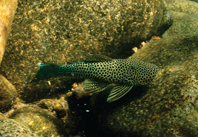Abstract
Reversal of male genitalia are known in various insect orders, such as in Odonata, Orthoptera, Dermaptera, Hemiptera and Trichoptera (Schilthuizen 2007) and, within the Dictyoptera, in several species of Ectobiinae (Blattodea) (Bohn 1987), and Mantodea. Balderson (1978) first described reversal of the phallic complex in Stenomantis Saussure and Ciulfina Giglio-Tos, reporting this condition in eleven of 17 specimens representing two species of the latter—informally named as “Ciulfina sp.2” and “Ciulfina sp.7” (see Balderson 1978: 238). Subsequently, Anisyutkin & Gorochov (2004) reported the same condition at the time of describing Haania doroshenkoi from Cambodia. The male external genitalia within the Mantodea (“praying mantises”) are markedly asymmetrical and generally develop in a single orientation (Klass 1997; Huber et al. 2007). Typically, the phallic complex consists of three phallic lobes surrounding the gonopore, all contained in a genital chamber between the ninth sternite and the paraprocts. Two of the three phallic lobes (phallomeres of La Greca 1955) are situated above the gonopore—one to the left and one to the right—while the third lies ventral to the genital opening. The right phallomere (RP) (Fig.1) (“right epiphallus” of Beier 1964) is usually dorsally positioned and its base extends almost completely across the wall of the genital chamber. The left phallomere (LP) (Fig.1) (“left epiphallus” of Beier 1964) is the most complex of the three lobes and it lies above the ventral phallomere (VP) (Fig.1) (hypophallus of Beier 1964).
References
Anisyutkin, L.N. & Gorochov, A.V. (2004) Haania doroshenkoi, a new species of mantises from Cambodia (Mantina: Mantidae: Thespinae) and a case of mirror symmetry in the structure of the male genitalia of mantises. Russian entomological Journal, 13, 119–122.
Bohn, H. (1987) Reversal of right-left asymmetry in male genitalia of Ectobiinae (Blattaria: Blattellidae) and its implications on sclerite homologization and classification. Entomologia scandinava, 18, 293–303.
Balderson, J. (1978) Reversal of the phallic complex in the genera Ciulfina Giglio-Tos and Stenomantis Saussure (Mantodea: Mantidae: Iridopteryginae). Journal of the Australian entomological Society, 17, 235–239.
http://dx.doi.org/10.1111/j.1440-6055.1978.tb00150.xBeier, M. (1964) Ordnung: Mantodea Burmeister 1838 (Raptaroirae Latreille 1802; Mantoidea Handliesch 1903: Mantidea auct.) In: Bronns Klassen und Ordnungen des Tierreichs, 5 (III), Abt. 6. Buch. 5, pp. 849–970. [Leipzig]
Holwell, G.I. & Herberstein, M.E. (2010) Chirally dimorphic male genitalia in praying mantids (Ciulfinia: Liturgusidae). Journal of Morphology, 271, 1176–1184.
http://dx.doi.org/10.1002/jmor.10861Holwell, G.I., Kazakova, O., Evans, F., O’Hanlona, J.C. & Barry, K.L. (2015) The functional significance of chiral genitalia: patterns of asymmetry, functional morphology and mating success in the praying mantis Ciulfinia baldersoni. PlosOne, 10 (6), e0128755.
http://dx.doi.org/10.1371/journal.pone.0128755Huber, B.A., Sinclair, B.J. & Schmitt, M. (2007) The evolution of asymmetric genitalia in spiders and insects. Biological Reviews, 82, 647–698.
http://dx.doi.org/10.1371/journal.pone.0128755Klass, K.D. (1997) The external male genitalia and the phylogeny of Blattaria and Mantodea. Bonner Zoologische Monographien, 42, 1–341.
La Greca, M. (1955) Sulla struttura morfologica dell'apparato copulatore dei Mantoidei. Annali Dell’Istituto Superiore di Scienze e Lettere “S. Chiara” di Napoli, 4, 1–28. [1953–1954]
Lombardo, F., Stiewe, M., Ippolito, S. & Marletta, A. (2014) A taxonomic revision of Otomantis Bolivar, 1890 (Mantodea: Hymenopodidae, Acromantinae) with description of five new species. Zootaxa, 3797, 169–193.
http://dx.doi.org/10.11646/zootaxa.3797.1.13Schilthuizen, M. (2007) The evolution of chirally dimorphic insect genitalia. Tijdschrift Entomologie, 150, 347–354.
http://dx.doi.org/10.1163/22119434-900000234

